GALAPAGOS TO FRENCH POLYNESIA
This passage would be our longest in terms of miles – 3,005 – but it would be two days shorter than our passage across the Atlantic – 19 days versus 21. Again, this passage was not what we expected. We expected light air and smooth seas. We had a bit more wind than expected, and it was not from the direction predicted, and the seas were much bumpier than expected.
We left Isla Isabela in the Galapagos mid-day on Thursday, June 19 – the last day on our visas – and it was a bit bumpy. We passed a small fleet of fishing boats during the cold night (we were wrapped up in fleece blankets), and we would see only three more boats during the next 18 days. We actually saw only two, but we picked up a third on AIS.
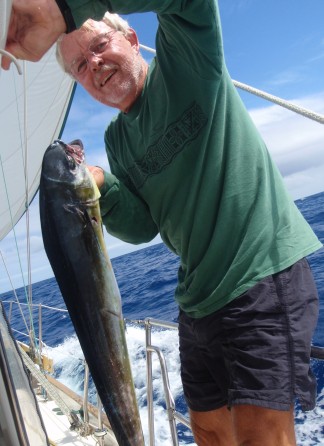
1st of two mahi mahis
The seas were bumpy from the start. We had swell from the south, southeast, and east at times. We also had wind waves and chop on top of it. The seas would increase or decrease slightly, but they remained bumpy enough to be uncomfortable for our entire passage. And they were forward of the beam for the first few days.
On day four, the seas calmed enough that we threw in a fishing lure and quickly caught a mahi mahi. But the seas returned. Day five is the first time the winds backed behind our beam, but they also increased to 24 knots for a while.
We had a bit of intermittent rain for a few days, and the seas were a bit calmer during the rain. And we noticed a pattern to the seas – they would calm a bit for a few hours during the night then really kick up shortly after daybreak. There was nothing we could do to change the pattern, but we could have our sails let out or shortened in anticipation.
The winds continued to back. They were 50 degrees less than the predicted direction. To maintain our northing, we needed to run dead down, and we knew that would be a rolly point of sail in those seas. We poled out the jib to starboard. And we rolled. We took it down once, but we could not maintain our course, so we reset it. We tried tacking the jib across, but we could not hold it. We kept it poled out.
At the end of our first week at sea, we had sailed 1,085 miles. That is an average of 155 per day or 6.46 per hour. We were pleased with that.
Our eighth night out was squally with winds varying between 11 and 25 knots and rain. But it calmed enough in the morning that we again tossed in a lure and caught another mahi mahi. But this was a little one, so we threw him back.
Our ninth night brought light winds (10 – 14 knots), but we rolled in the seas. We motorsailed a while to keep moving and make some hot water (warm showers). We caught another mahi mahi – this one a keeper. And our wind generator stopped turning. Just stopped.
We crossed our halfway mark on day 11. We celebrated with beer and Good & Plenty – Bud had a beer and Nita had Good & Plenty she had stashed away for just such an occasion. Dolphins visited us. We resigned ourselves to rolling downwind for a few more days to maintain our northing. Then more stuff broke. We had a problem with our wind vane that caused us to stop using it (we would fix it over the next few days), and the hard drive on our built in computer started making noise. We got out our backup laptop computer, and it would not boot. Not a good day.
While in Gibraltar a few years ago, we were having frequent computer crashes, so we had a local shop change out our hard drive.We still had the drive that was removed/replaced. Now we could not persuade the laptop to boot, so we put it away. We removed our current hard drive from our built in computer and installed the ‘old’ drive while underway in bumpy seas. A challenge (neither of us had ever changed out a hard drive before), but a successful effort. Our built in computer was working again even if not perfectly. And our wind generator started working again. But our wind vane was not operable.
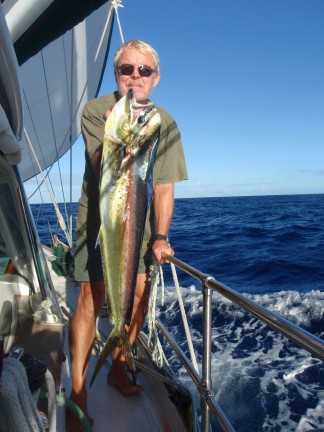
2nd mahi mahi
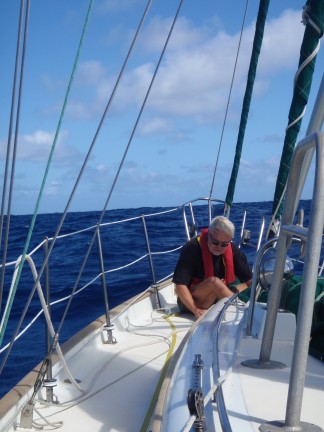
Setting pole
Conditions got more uncomfortable. On day 13, the afternoon winds increased to 25 knots and the seas were 12’ and rolly. We had a miserable rolly night.
On day 14, we decided that we had had enough of sailing wing-and-wing in these conditions. If we got pushed further south than we wanted, we would deal with it later. We dropped the pole and sailed on a broad reach with less roll. Bud got the wind vane working again.
During our second week out, we sailed 1,153 miles for an average of 165 per day or 6.86 per hour. We had one day of 179 miles. This is very fast for us, but we had lots of current with us.
Day 15 started out bumpy and rolly, but the chop abated, and we had some nice sailing in the evening. This was the first time since leaving Isabela. Then during the night, a line on our tillerpilot broke, and we had to resume using our main autopilot (a work horse but a power pig) for a while.
Day 16 was a return to the usual bumpiness, but we got the tillerpilot line repaired. The afternoon winds increased to 25 and the seas returned to 12’. We have never been knocked down, but we came as close as ever this day. One swell had picked us up, and while sitting atop it, another came from another direction and knocked us off our 12’ tall perch. It felt like we had been hit by a train. All was well except our spirits. We were tired of the seas. And it remained bumpy all night.
Days 17 and 18 were the same. The boat motion was quite uncomfortable. We would have squalls with winds of 25 knots, then the winds would drop and we would need to motorsail. But the end was in sight, and we had to plan for our landfall.
We calculated that we were not likely to reach our destination, Hiva Oa, before dark on July 7, so we would slow and plan our arrival for the morning of July 8. It remained very bumpy, but we pressed on slowly.
On the morning of July 8, we had dolphins swim with us as we motorsailed along the south coast of Hiva Oa. We caught a big barracuda – a fish that neither of us likes at all – so we threw him back and put away our fishing gear. We anchored in Tauhaka Bay at Atuona, Hiva Oa, Marquesas at 1933 GMT.
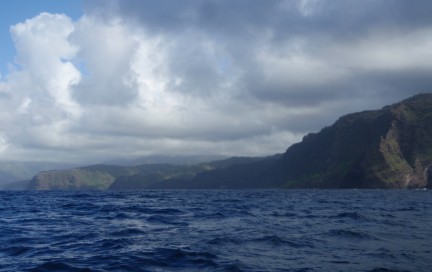
Approaching Hiva Oa, Marquesas
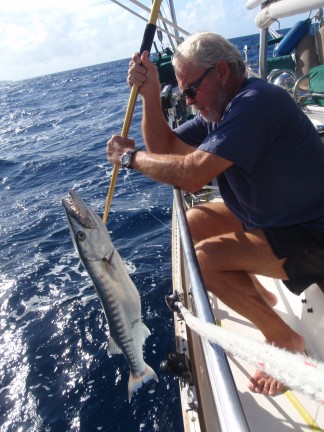
Barracuda
Our total passage time was 19 days, 1 hour, 20 minutes. We sailed 3,005 miles in 457 hours for an overall average of 158 per day or 6.58 per hour. Our fastest day was 179 miles for an average of 7.46 per hour. Our slowest day – when we were intentionally slowing for daylight arrival – was 134 miles for an average of 5.58 per hour. We could not have made this speed without the considerable current that ran with us for most of the sail.
We were surprised by both the winds and the seas on this sail. The winds were close to predicted strength, but their direction was consistently 20 to 50 degrees less than the predicted direction. The seas were more than we expected. We had swell from three directions – sometimes simultaneously – and almost constant wind waves/chop. The seas would have been uncomfortable on any point of sail, but they were particularly uncomfortable while running dead down wind to deal with the unexpected wind directions. But we had no problematic weather other than the occasional expected squall, and we had current – sometimes a lot – running with us almost the entire way.
Now we needed to get some sleep and clean up our boat!
Come along as we visit French Polynesia.